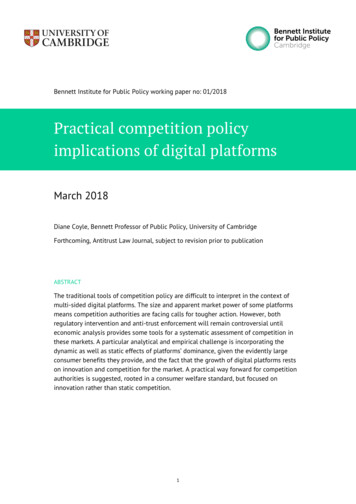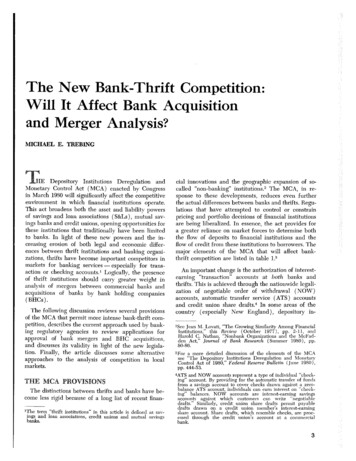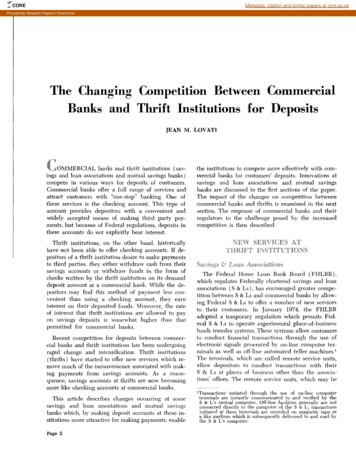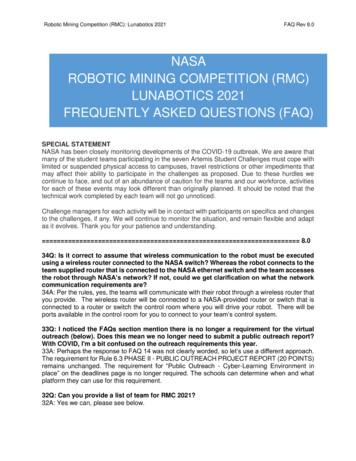
Transcription
Bennett Institute for Public Policy working paper no: 01/2018Practical competition policyimplications of digital platformsMarch 2018Diane Coyle, Bennett Professor of Public Policy, University of CambridgeForthcoming, Antitrust Law Journal, subject to revision prior to publicationABSTRACTThe traditional tools of competition policy are difficult to interpret in the context ofmulti-sided digital platforms. The size and apparent market power of some platformsmeans competition authorities are facing calls for tougher action. However, bothregulatory intervention and anti-trust enforcement will remain controversial untileconomic analysis provides some tools for a systematic assessment of competition inthese markets. A particular analytical and empirical challenge is incorporating thedynamic as well as static effects of platforms’ dominance, given the evidently largeconsumer benefits they provide, and the fact that the growth of digital platforms restson innovation and competition for the market. A practical way forward for competitionauthorities is suggested, rooted in a consumer welfare standard, but focused oninnovation rather than static competition.1
IntroductionConcern about the size and market power of some large digital platforms has been onthe increase, widely reflected in the media (see for example Farahoor 2017, Gapper2017, The Economist 2016). The growing concern is also manifesting itself in officialanti-trust actions such as the European Commission’s recent 2.42 billion fine imposedon Google for abusing its dominance in ‘demoting rival comparison shopping services inits search results’ to advantage its own service; and in policy proposals andinvestigations such as the European Commission’s ongoing Digital Single Marketprogram or the wide-ranging Australian Competition and Consumer Commission inquiryinto the market power of digital platforms.1However, it will prove difficult to address these concerns until there is greaterconsensus in the academic and practitioner literature as to how to analyse marketpower and the competitive process in the case of digital platforms. There is a rapidlyexpanding theoretical literature on these models, but not yet a consistent analyticalframework, and scant empirical evidence about the market and consumer welfareeffects of the platforms (see for example surveys by Coyle, 2016; Auer and Petit, 2015).As the earliest work in this literature dates back only to about 2003, it might beconsidered too early to expect the research to have translated into agreed, practicalcompetition policy tools. Unfortunately, the need on the part of antitrust authorities isurgent. For, certainly since the arrival and rapid spread of smartphones after 2007, andsubsequent business model and algorithmic innovations, the proliferation of digitalplatforms and growth of some of them has been striking. The need for some practicalapproaches is imperative. While further rigorous theoretical and empirical research iscertainly needed, this paper offers some immediate practical proposals. It focuses onthree areas to consider in any competition assessment of digital markets:-What are the incentives to invest and innovate in any specific case, given thatcompetitive dynamic in these markets (as other technology markets) takes the formof disruptive innovation? And, as major innovation is often due to new entrantsrather than incumbents, have the incumbents erected barriers to entry at minimumcommercially viable scale?-What dynamic consumer disbenefits offset the undoubted static consumer benefitsin digital platform markets, and what is the scale of each?-What is the impact on competition in adjacent and upstream markets of entry oracquisition by a large incumbent digital platform? In particular, what are the effectson the incentives to invest and innovate across the ecosystem?Even in the absence of standardised techniques comparable to familiar existingprocedures such as the SSNIP test or market definition exercises, answers to these sets1http://europa.eu/rapid/press-release IP-17-1784 en.htm; e-platforms-digital-single-market; platforms-inquiry2
of questions will give some practical guidance, firmly rooted in the analysis ofconsumer welfare, yet going beyond the conventional focus on firms’ pricing behaviour.Platform economics and traditional competitionassessmentAn immediate difficulty in antitrust analysis is the lack of a clear, broadly agreeddefinition of a multi-sided platform (MSP). Although there is agreement about some oftheir core economic characteristics, the economics literature contains several variants,of different degrees of precision (Rochet & Tirole 2003, 2006; Evans & Schmalensee2014, Armstrong, 2006). MSPs are agreed to have at least two ‘sides’, users andproviders, or buyers and sellers. There are indirect network externalities such thatparticipants on each side benefit, the more numerous are the participants on the otherside. For example, travellers benefit from more hotels being on the platform, and hotelsfrom there being more potential travellers, on an online travel agency platform. Theplatform opportunity exists when the different sides cannot transact separately tocapture the value of the indirect network externalities themselves (Evans andSchmalensee, 2013, p7). While platforms in this sense have existed for a long time(bazaars, stock exchanges, operating systems), the new digital platforms have greatlyextended the scope of possible transactions thanks to matching algorithms and thetechnologies of broadband and smartphones or other devices (Coyle 2016).More formally, “A market is two-sided if the platform can affect the volume oftransactions by charging more to one side of the market and reducing the price paid bythe other in equal amount; in other words, the price structure matters, and platformsmust design it so as to bring both sides on board,” (Rochet and Tirole, 2006, p664).However, this is not an operational definition so much as a post hoc description; and thesubsequent and rapidly growing literature on MSPs refers to them, variously, asbusinesses, markets, or networks, as well as platforms. This is not surprising, perhaps,as they blur the boundary between production and exchange, having features of bothbusinesses and marketplaces. They use various types of coordinating mechanism (suchas matching algorithms, technical standards, or information capture and classification)in place of the traditional co-ordination via time and place. Some organizations operateboth as one and two sided businesses (for instance, Amazon as a retailer and AmazonMarketplace as a platform) (Coyle 2016). Many digital organizations are looselyconsidered as platforms, while some non-digital-era businesses are also consideredwith hindsight to be platforms. Auer and Petit (2015) note that the scholarly literaturehas failed to converge on a definition because of a lack of conceptual clarity aboutwhich businesses merit classification as MSPs, resulting in disagreements in theliterature, and some businesses that could surely be defined as conventional verticallyintegrated organisations being regarded as platforms. Indeed, to a large extent,operating as a platform is a business model choice; for instance, selecting advertisingfunding rather than a subscription model. Auer and Petit propose the importance of theCoaseian opportunity, rather than network effects alone, as a defining feature: platformsreduce transactions costs by enough to enable transactions that would otherwise notoccur, internalizing the externality.3
If either new ex ante regulations or competition policy analytical tools are to be appliedto digital platforms, then a clearer operational definition will be necessary. Meanwhile,however, there is clearly growing concern about the scale and perceived power of somelarge digital platforms. This includes the group often referred to collectively as GAFAM(Google, Amazon, Facebook, Apple, Microsoft), but to some extent also other large orfast-growing businesses in different sectors, such as Uber, Airbnb, Booking.com andDeliveroo. These businesses are involved in a wide range of different activities, onlysome parts of which can be characterized as MSPs.From the perspective of competition authorities, such platforms pose several challenges,including the extent to which sheer size should be a concern. However, one specificchallenge is precisely that price on each side of the market will not be reflective ofmarginal cost on that side, as the price structure and level will be set separately. Thismakes traditional SSNIP tests non-operational as the prices set by the platform on eachof its ‘sides’ cannot be considered in isolation.The standard market definition exercise is equally inapplicable because of the feedbacklinks between the two (or more) sides. As a result of these links, one form competitionbetween platforms takes is ‘envelopment’, or in other words adding another group ofcustomers on one side and using those revenues to reduce the price charged to anotherside of the platform (Eisenmann et al, 2010). Platforms therefore often adopt thisstrategy once they have a large user group ‘on board’. For instance, Uber has moved intofood delivery with Uber Eats, while Google has moved beyond its original searchbusiness to add a wide range of others (not all platform-type models). Platforms mayalso adopt the bundling or tying of services in order to cross-subsidise betweendifferent groups of users when they are unable to set a negative price to subsidize oneside directly (Amelio & Jullien, 2012). Envelopment or bundling strategies may buildbarriers to entry in the ‘enveloped’ markets. For it will become harder for smallerplatforms, without so many groups on board, to match the prices or services of thebigger incumbent able to take advantage of cross-subsidies.What’s more, with any matching platform, while price is clearly relevant to the welfareassessment, the products or services will be highly differentiated; variety and bettermatching of supply and demand features is part of the economic welfare they create.Anti-trust enforcement has for a considerable time applied a consumer welfare standard,often attributed to the influence of Robert Bork’s book The Anti-Trust Paradox (1978)and subsequent Chicago School work (Shapiro 2017, Khan 2017). In practice, priceshave been taken as the indicator of consumer welfare, but in any technology market,product characteristics will be at least as important (Pleatsikas and Teece 2001). Clearlywhen the consumer-side price is zero, as on many platforms, all the direct competitivepressure is exerted through service quality and innovative features. Althoughcompetition guidelines often pay lip service to quality and other characteristics asfeatures of competition, in practice there is a focus on price as it is definitionally crispand easier to measure; for example, the UK’s Competition and Markets Authority MergerAssessment Guidelines state that competition “Creates incentives for firms to cut price,4
increase output, improve quality, enhance efficiency, or introduce new and betterproducts,” but subsequent amplification refers almost entirely to prices.2Third, the phenomenon of ‘multihoming’ may have counterintuitive implications. On theconsumer side, multihoming, where the typical consumer signs up to several platforms,is reasonable sign of competitive pressure. If the platform delivers an inferior service orprice, it is likely to lose consumers on that side of its business. On the supplier side,however, strong competition could lead suppliers to avoid multihoming, for if closerivals select different platforms, they may dilute the competitive pressures they face, tothe extent that buyers on the other side do not monitor all platforms. In this case therewould be multiple similar platforms charging high fees. If there is less competitivepressure among suppliers, the network effects will lead them to join a dominantplatform, and platforms will be competing for the market but charging low fees to userson this side. The correlation between price and concentration (in terms of the platform)is exactly the opposite to what intuition would suggest (Karle et al 2017).Finally, platforms face what the literature refers to as the ‘chicken and egg’ problem, orin other words the need to expand both sides in an appropriate balance (Evans 2011).The indirect network effects attracting users on each side to the platform mean that theplatform has to be sure to have enough of each, and until it reaches critical mass this islikely to be loss-making. However, once it does reach the critical point, a platform canquickly grow to a large scale, thanks to the power of the indirect network effects. Thetypical dynamics make it hard to interpret profitability in terms of competition andmarket dynamics. Many platforms fail without ever having made a profit (Evans 2011).When they reach profitability, investors will have a reasonable expectation of a returncommensurate with the risk. Indeed some digital businesses – Amazon for instance –report negative to low profits for long periods. This is sometimes seen as a cause forconcern, as the motivation is taken to be the desire to grow to a dominant position inone or more markets (Khan 2017). This too is an inversion of the normal intuition,which would see low profits as a reason to be relaxed about competition, not theopposite.Many of these new challenges reflect a more acute version of a longstanding dilemmain competition assessments, namely how to weigh static against dynamic efficiency.The emphasis in practice to date has been on static efficiency. To a large extent, this isdue to the legal framework. For example, in Articles 101 and 102 of the Treaty on theFunctioning of the European Union3 the descriptions of proscribed behavior are given interms of static efficiency
2014, Armstrong, 2006). MSPs are agreed to have at least two ‘sides’, users and providers, or buyers and sellers. There are indirect network externalities such that participants on each side benefit, the more numerous are the participants on the other side. For example, travellers benefit from more hotels being on the platform, and hotelsFile Size: 577KBPage Count: 20











